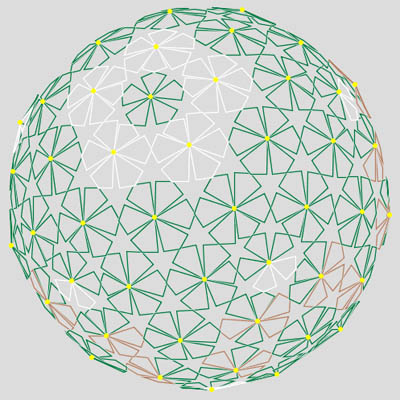 Screenshot of DaisyWorld Simulation Credit: GingerBooth.com |
Long long ago in a galaxy far far away, there was a cold, gray planet named DaisyWorld orbiting a star much like our Sun. On this planet some aliens scientists sprinkled some seeds that produced only white and black daisies. The aliens were performing an experiment just like James Lovelock’s 1983 thought experiment, which might seem like a really big coincidence, but great minds think alike and there are over a hundred billion galaxies in the Universe and a hundred billion stars just in our own galaxy. So the odds are pretty good that somewhere out there this is a true story.
So could you please just play along for a moment? Thanks.
At first, only the black daisies could survive on this cold planet. Their black coloration allowed them to absorb sunlight as thermal energy, like leather car seats, keeping them warm through the harsh winters, while the white daisies reflected sunlight back into space, absorbing very little of the sun’s heat. DaisyWorld was almost completely covered in black daisies.
The heat absorbed by the black daisies was released to the rest of the planet, which began to heat up very slowly. Over… oh… let’s say a million years, DaisyWorld became warm enough for the white daisies to survive a little bit too.
(It should also be noted that these were special daisies that always reproduced perfectly every time, without mutation, which is why evolution and biodiversity aren’t included in this story to complicate things for us.)
Eventually, DaisyWorld got so warm that the black daisies’ ability to absorb sunlight as heat became deleterious to their survival, and they began to wilt. This left room for the white daisies to thrive, because they could keep cool by reflecting sunlight instead of absorbing it, and soon DaisyWorld was covered in white daisies.
But the white daisies didn’t absorb much sunlight as thermal energy, instead they reflected that light back into space, and in just a few million years, DaisyWorld got cold again.
Again the black daisies thrived, warming the planet, and then the white daisies, cooling it. Back and forth, back and forth, like a swing, DaisyWorld got hot and cold.
But, also like a swing left to swing on its own, each of DaisyWorld’s temperature extremes became less and less severe. Until eventually there was just the right number of black and white daisies to keep the planet at just the right temperature for all of them.
Then all the daisies lived happily ever after—or at least until an asteroid caused a mass extinction or their sun went supernova or the eventual heat death of the Universe.
Even the aliens were happy, because their experiment supported their hypothesis that biological and physical components of a planet form a complex interacting feedback system that maintains conditions in a preferred homeostasis.
The End.
See Also:
- ThinkQuest has a spiffy flash demo explaining DaisyWorld
- A collection of Graphs and Equations explaining DaisyWorld.
- GingerBooth has a DaisyWorld Simulation worth checking out.
- Another DaisyWorld Applet. This one much more complex.
- Also consider the feedback loop our CO2 and methane emissions are producing on our planet with this video of the last 30 years of Arctic Ice disintegration. Ice reflects sunlight back to space like the white daisies, water absorbs sunlight as thermal energy:
Comments
3 responses to “DaisyWorld, A Fable of Planetary Homeostasis”